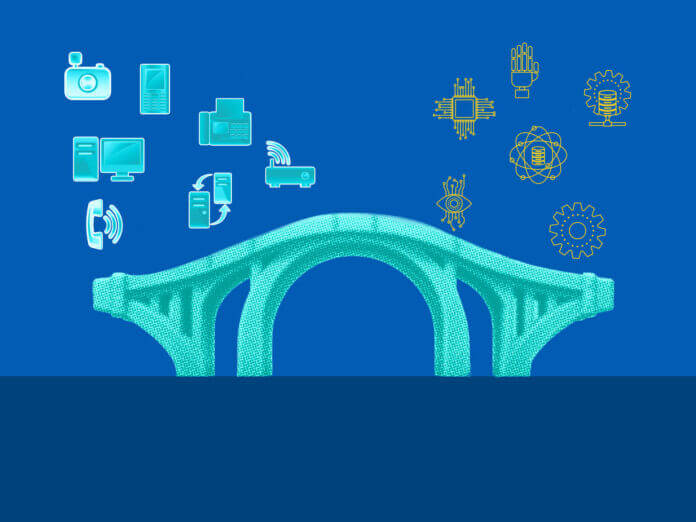
Digital transformation (DX) has become a crucial aspect of modernizing organizations and maximizing their agility, control, and value.
As the landscape of DX continues to evolve, new methodologies and technologies are emerging, such as artificial intelligence (AI), machine learning (ML), development, security and operations (DevSecOps), automation, and low-code solutions. These advancements are prompting building owners and office managers to rethink their approach to the traditional ‘rip and replace’ strategy when dealing with legacy systems.
DX is not just about individual systems; it’s about orchestrating the total experience. This involves modernizing legacy systems, integrating cloud applications, and managing diverse endpoints, from smartphones to older devices.
Efficient data management is key to improving processes and workflows across organizational, geographical, and regulatory boundaries. Organizations need to architect their transformation efforts to ensure seamless integration and data accessibility.
Digital Transformation and Advanced Middleware
As organizations consider their digital transformation journey, the concept of rip and replace no longer holds the same appeal. Instead, they seek solutions that allow for seamless integration with existing legacy systems while leveraging the benefits of new technologies.
For your digital transformation journey, It is important to choose a middleware platform that connects, controls, and communicates with both legacy systems and new technologies.
The correct middleware should act as a bridge between the old and the new, enabling organizations to harness the power of big data, sensors, devices, and control systems without the need for a complete rip and replace. This approach allows organizations to protect their investment in legacy systems while gradually transitioning to more advanced and efficient technologies.
If you are out of your depth with implementing middleware then finding an experienced system integrator or solution provider will significantly improve the process of connecting and integrating different systems, as well as creating a unified ecosystem that optimizes operations and enhances data accessibility. By
By leveraging the advanced features and capabilities of the correct middleware, organizations can avoid the costly and disruptive rip-and-replace approach.
What is Middleware?
The ability to connect, control, and communicate with devices and systems is crucial for businesses across various industries. It is a fundamental aspect of this seamless integration is being protocol agnostic.
Middleware is a bit of everything. Being Protocol-agnostic refers to the ability of a system or device to work seamlessly with multiple communication protocols, regardless of the underlying technology or infrastructure.
In the context of the Internet of Things (IoT), this means that devices can communicate and exchange data with each other (Wi-Fi, LoRaWAN, EnOcean, Bluetooth, Power over Ethernet (PoE), MQTT, etc), regardless of the specific protocols they use. This flexibility allows businesses to choose the best devices for their specific needs, without being limited by compatibility issues.
The Importance of Protocol-Agnostic Middleware
Scalability and Flexibility
IoT solutions often start small, with a proof of concept (PoC) or a pilot project. However, as businesses grow and expand, their IoT needs may evolve and require a larger-scale implementation.
Protocol-agnostic middleware allows businesses to scale their IoT solutions seamlessly, from a single device to thousands, without major compatibility issues, providing ease for your digital transformation. This scalability and flexibility ensure that businesses can adapt and grow their IoT infrastructure as needed, without being constrained by specific protocols.
Futureproofing and Interoperability
Technology is constantly evolving, and new communication protocols are regularly introduced. Being protocol-agnostic future-proofs businesses’ IoT investments by ensuring that their devices can adapt and work with new protocols as they emerge.
This also promotes interoperability, allowing devices from different manufacturers and suppliers to work together seamlessly. This is crucial for creating a unified and efficient IoT ecosystem, where devices can communicate and share data effortlessly.
For example, you may wish to use LoRaWAN for long-range estate management for daily updates on water quality or silo levels but use EnOcean in your offices to monitor desk occupancy and air quality on a minute-by-minute basis.
Both are excellent systems but one is long distance, low power and the other is high-frequency short range, so by combining these with a protocol agnostic middleware solution, you end up with a very powerful, data accurate, reliable, and robust solution all running through one system, enabling actionable insights, automated responses and a view of your assets all in one place.
The Right Middleware for Your Digital Transformation
In short, choosing the right middleware for your digital transformation journey can make or break your rollout strategy and costs can spiral out of control if you get it wrong. Make a plan, prioritize the crucial, the critical, the important, the nice to haves, and then icing on the cake.
This way you can manage everyone’s expectations and deliver a gradual upgrade to your current systems (if you have them). Dashboards, graphs, and charts look great for a couple of weeks, but it is the automated responses, the actionable insights, the cost reductions, and the impact on NetZero and Environmental, Social, and Governance (ESG) targets that matter.
- SEO Powered Content & PR Distribution. Get Amplified Today.
- PlatoData.Network Vertical Generative Ai. Empower Yourself. Access Here.
- PlatoAiStream. Web3 Intelligence. Knowledge Amplified. Access Here.
- PlatoESG. Carbon, CleanTech, Energy, Environment, Solar, Waste Management. Access Here.
- PlatoHealth. Biotech and Clinical Trials Intelligence. Access Here.
- Source: https://www.iotforall.com/rethinking-rip-and-replace-middleware-and-digital-transformation



